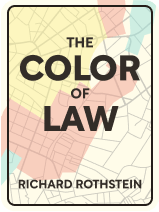

This article is an excerpt from the Shortform book guide to "The Color of Law" by Richard Rothstein. Shortform has the world's best summaries and analyses of books you should be reading.
Like this article? Sign up for a free trial here .
How did estate agents perpetuate real estate discrimination? What was the response of the government to racism in real estate?
Agents perpetuated real estate discrimination using tactics like restrictive covenants, contract sales, and blockbusting to deny African Americans access to quality, high-value properties. The government’s response to racism in real estate was to condone and even help enforce these unfair practices.
Read more to fully understand the scope of real estate discrimination by estate agents.
Restrictive Covenants: An Effective Weapon for Real Estate Discrimination
Years before the FHA adopted explicitly discriminatory policies that furthered racism in real estate, private homeowners and developers regularly included racist “restrictive covenants” with deeds to particular properties. These covenants were ignored, then propped up, by the federal government, and so constitute a further incidence of de jure segregation.
Restrictive covenants comprised the obligations a purchaser of a property was agreeing to when he or she assumed ownership. They included stipulations concerning the color(s) the home could be painted or what kinds of foliage an owner could plant. They also frequently included a clause that forbade the owner from selling or renting to an African American. In the 20s, it was not uncommon to find among the list of prohibitions—of constructing a slaughterhouse or smithy on the premises, of producing noxious odors through manufacturing—a line limiting the property to “people of the Caucasian race” (with the notable exception, of course, of domestic workers). Often all the homes in a particular area would feature racist restrictive covenants, thus limiting that area to whites only.
The problem with restrictive covenants, at least to property owners that wanted to keep their neighborhoods segregated, was that they were difficult to enforce if a particular property owner wanted to sell to an African American. For example, if a white homeowner wanted to violate the covenant and sell property to an African American, there was little his or her segregationist neighbors—who would be the ones “hurt” by the sale—could do about it. So, to get around this wrinkle in the law, developers began making it a requirement for purchasing their properties that the purchaser join a community association—an association whose bylaws often included a whites-only clause.
One example of this real estate discrimination strategy can be found in the Country Club District in Kansas City. In the 20s, a developer named JC Nichols built 6,000 homes and 160 apartment buildings for a total of 35,000 residents. In order to own property in the district, residents had to join the district’s association, whose rules forbade sales or rentals to African Americans. Similar arrangements that perpetuated real estate discrimination could be found across the country: in locales as diverse as Boston, New York City, Chicago, Detroit, and Seattle.
The Government Steps in—to Protect Restrictive Covenants
As one might expect given the policies of the HOLC and FHA, the federal government condoned—and even helped enforce—racial restrictive covenants.
A key precedent was a 1926 Supreme Court case that found racial restrictive covenants constitutional, on the grounds that they were private contracts between consenting citizens. This gave subsequent administrations legal standing to promote segregation by covenant. For example, during Hoover’s President’s Conference on Home Building and Home Ownership, officials urged developers to adopt “appropriate restrictions” to maintain property values. The model restrictions they referred to included provisions prohibiting sale or occupancy to African Americans.
It was during the New Deal, however, that real estate discrimination reached its zenith. Not only did FHA appraisers award high ratings to neighborhoods with low or null African American residency, but they also awarded high ratings to properties with restrictive covenants. In fact, the FHA’s 1936 underwriting manual explicitly stated that deeds for insured properties should include (1) racial restrictive covenants and (2) provisions for neighborhood enforcement of the covenants (for example, community association bylaws).
The FHA also encouraged builders to use restrictive covenants. For example, when the government commissioned developer David Bohannon to build Rollingwood, an all-white subdivision near Richmond, CA, the government required Bohannon to include racial restrictive covenants with the deeds to the properties.
Undercutting Shelley vs. Kraemer
In 1948, in Shelley v. Kraemer, the US Supreme Court overturned its 1926 ruling and decided that racial restrictive covenants were indeed unconstitutional. The 6-0 majority reasoned that, because covenants had to be enforced by courts and courts were barred from participating in real estate discrimination, racial restrictive covenants were unenforceable. (The court was down to six justices because three recused themselves—because those three possessed deeds with racial restrictive covenants.)
However, for the next 14 years, the FHA simply ignored the ruling in Shelley v. Kraemer, justifying its continued support of restrictive covenants by appealing to a “fact” of integrated neighborhoods: that the presence of African Americans reduced property values and so constituted a greater risk of loan default. It wasn’t until President John F. Kennedy issued an order forbidding the FHA to contribute to racial discrimination that the practice ended.
Courts, too, tended to undercut the spirit of the ruling. In a state supreme court case in Missouri, the court found that, though an African American purchaser of a restricted home couldn’t be evicted, the seller could be sued by their neighbors for damages. In Oklahoma state supreme court, the court ruled that both the seller and the buyer could be held liable.
These circumventions of Shelley ceased in 1953, when the US Supreme Court expressly barred both evictions and the recoupment of damages in cases involving restrictive covenants. Still, the Court didn’t take the step of banning racial restrictive covenants outright. That ruling would have to wait until 1972.
Blockbusting, Contract Buying, and White Flight
In addition to its direct contributions to racial residential segregation—by curtailing African Americans’ ability to purchase homes outside redlined districts and supporting whites’ efforts to resist integration—the FHA also indirectly contributed to residential segregation by enabling discriminatory private real estate practices.
Blockbusting
One such practice was “blockbusting.” To “blockbust” a neighborhood, real estate agents would gin up fear among white residents of a white neighborhood that African Americans were about to move in. Because it was the position of both the FHA and the real estate industry that the presence of African Americans in a neighborhood meant declining property values, whites could be persuaded to sell their homes to these real estate agents at discounted prices. The agents would then turn around and sell these properties to African Americans at a premium. The arrival of more African Americans would persuade more white residents to sell—so-called “white flight”—and the cycle would continue until the neighborhood was fully African American.
Sometimes, agents wouldn’t even have to actually sell a home to an African American to catalyze white flight. For example, agents were known to pay African American women to walk through white neighborhoods with their babies in carriages, or African American men to drive through neighborhoods with the radio turned up, to nudge whites toward selling.
The irony of blockbusting is that statistical evidence shows African Americans actually raised property values. Because the FHA refused to insure their mortgages, African American families tended to have to pay higher prices than whites to move into comparable housing, thereby raising the average value of a home in whatever neighborhood they’d chosen.
In truth, the FHA’s position that African Americans reduced property values was a self-fulfilling prophecy: Although average values initially rose with the arrival of African American families, blockbusting would drive average prices back down due to whites’ selling at discounts.
Contract Buying
Another private-real-estate practice that disproportionately harmed African Americans was the “contract sale.” Under the terms of a contract sale, the deed to the home would transfer to the buyer after fifteen or twenty years, but only if the buyer made every monthly payment over the term of the contract. If the buyer didn’t, they could be evicted immediately—because the payments didn’t earn the buyer equity in the home. Contract buying was common in many cities, but arguably none more so than Chicago. In the 1960s, approximately 85% of property purchased by African Americans was on contract.
The repercussions of these burdensome payments—which were inflated by discriminatory real estate agents—were many and varied. They forced buyers to work multiple jobs or take in boarders to earn enough just to make their payments (forget about maintenance). The additional boarders created overcrowding in homes and local schools—so much so that many schools had to switch to morning shifts and evening shifts. The shifts gave rise to gangs, which gave rise to criminality, which caused whites to move out of integrated neighborhoods even quicker. Eventually, the neighborhood would deteriorate to the point of becoming a slum.
If the FHA had insured African American mortgages, they could have received home loans from reputable financial institutions on reasonable terms. Instead, African American home buyers were forced to deal with predatory real estate firms who took advantage of Blacks’ limited options.

———End of Preview———
Like what you just read? Read the rest of the world's best book summary and analysis of Richard Rothstein's "The Color of Law" at Shortform .
Here's what you'll find in our full The Color of Law summary :
- How racial residential segregation is the result of explicit government policy
- The three reasons why racial segregation is so difficult to reverse
- The steps that could lead to a more integrated and equitable society






